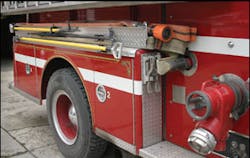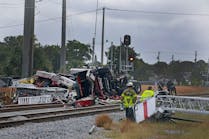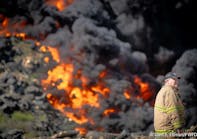Like most of my fellow officers, I love the challenge of arriving first-due at a fire. Nothing gets me going like pulling up on a building with flames and heavy smoke showing. After a quick 360, I radio an initial report, send the truck in to force entry, have the engine troops lead out the working lines and watch the hose drop as I send the engine to the hydrant. For me, though, those days are over.
Three years ago, I moved to Troy, OH, just north of Dayton, and joined a department protecting 88 square miles of predominately rural area. While I consider myself somewhat proficient in fighting fires in a city environment, I quickly realized that emergency incidents out here need to be approached differently. While a fire doesn’t know if it is in an apartment on the west side of Chicago or in a barn in Casstown, OH, in many cases, suppression strategy is not much different – it’s tactics that become a challenge. Since I teach quite a bit, and folks know me as a “city boy,†I’ve been asked lately what are the major differences in firefighting between the two areas and what would I consider, coming from a populated and congested urban area, important points to help improve rural operations.
A rural area is defined by the U.S. Census Bureau as an area with fewer than 500 people per square mile and our response district certainly qualifies as that. It is quite a contrast to being an engine company commander in a congested district in Danbury, CT, that has a population of about 78,000 packed into about 42 square miles. The first thing I learned out here is that water does not come easy in the country. The second thing is that even more difficult than getting enough water is finding, training and retaining qualified members.
Water Supplies
In the city, we could forward or reverse lay and obtain a positive water source from a hydrant relatively quickly. Out here, a lot of thinking has to first go into planning how you get enough water to show up in the right place when it is needed. There are 14 fire departments in Miami County, and it is standard practice, depending on the location, to dispatch three departments on the initial alarm to a structure fire reported in a rural area, just to make sure enough water is on the way. This becomes more challenging during the day when reduced staffing enters the picture.
How the water is handled on the scene is extremely important. Apparatus placement is key to the whole operation. If the first-due engine blocks the roadway, tankers will have to back up to offload their water, slowing the whole operation to a crawl. It’s not like having the pump operator stretch a line over a parked car to connect to a blocked hydrant. Block the road at a rural fire and everything comes to a halt.
Taking a chapter out of the city book, common practice is to have the first-due pumper lay a large-diameter hoseline (LDH) up the driveway and a second supply pumper set up a supply operation, drafting out of portable tanks set ahead or behind the pumper near the roadway.
During the planning stage, if the apparatus was designed properly, the job becomes much easier. For example, by equipping the supply pumper with front or rear large intakes, it becomes an easy job to connect a five-inch section of hard suction with a low-level strainer to draft out of the portable drop tank. If a pumper does not have a front or rear connection, a 45- or 90-degree large-suction elbow on a side inlet will let the pumper draft from a tank placed ahead or behind with a minimum of difficulty. Eliminating the side-placed drop tank provides more room for the tankers (called tenders out west) to drive by and quickly dump their loads.
I learned that as a rule, at a well-designed operation, a loaded tanker should never have to back up to dump its water. Many dump tanks have been damaged and firefighters injured when a large unit with relatively poor visibility to the rear makes a reverse move. If the rig is properly designed with side-mounted dump valves or provided with an elbow extension on the rear dump, things go much more rapidly and safely at the dump site.
Gaining more experience, I also learned that a pumper drafting at a fill site can fill tankers much faster than getting water from a municipal hydrant and that a properly designed tanker can be filled more rapidly with a short length of LDH instead of a couple of lengths of 2½-inch hose. Of course, the city boys already knew that a large-diameter line would flow more water than multiple smaller lines, but the country crews made things work faster by using Storz or cam-lock fittings in place of the slower-to-connect threaded fittings.
Early last year, we responded to a fire, fanned by 50-mph winds, in a turn-of-the-century brick school that was converted into a residence. Once the water supply was established with mutual aid tankers, there was no problem supplying a ladder pipe and various handlines. Later in the year, I attended a water-shuttle drill where the Union City, OH, Fire Department was able to sustain a flow rate of over 2,000 gpm for more than an hour using nine portable tanks at the dump site and 18 tankers from mutual aid companies traveling from four to seven miles round trip – quite impressive. It makes me think that when I hear the excuse, “We ran out of water,†it really means, “We failed to plan,†which is something that can be corrected. If you need ideas, National Fire Protection Association (NFPA) Standard 1142, Water Supplies for Suburban and Rural Firefighting, is the place to start. It tells you everything you need to know on how to get water to the fire scene more efficiently and with greater safety.
Coordinating Crews
Years ago, when most members lived and worked close to the fire district, staffing was a minor issue. With a sense of public duty, most employers did not mind if their employee-firefighters left work to respond to an incident. These days, that practice is becoming the exception rather than the rule. Because of changes in this country’s business economy, many members must travel farther to find employment as new factories open while nearby businesses close down. Candidates for membership are not as numerous as they once were; many leave town to seek employment or an education elsewhere.
With the ability of the Internet to bring the world and all its diversions into the most remote rural household, spending the night testing hose, cleaning the rigs or running a mask confidence course may not be as attractive as checking out favorite websites. Recruitment and retention of members can become a critical problem unless it is made a priority. (See “Volunteer Roundtable: Recruitment & Retention†on page 58.)
In the city, larger departments operate using standard operating procedures (SOPs) or standard operating guidelines (SOGs), and are trained to function as a tight group. While rural departments are usually located miles apart, participating in each other’s training and planning sessions pay off on the emergency scene, increasing efficiency and safety. For example, in our area, the first-arriving chief from a mutual aid department usually assumes the role of water supply officer, letting the chief having jurisdiction concentrate on operations.
Attack Tactics
Years ago, many chiefs from smaller departments would say that they attacked fires with booster lines so that they wouldn’t run out of water. I guess that in those days there was some type of award for the chief who had the most water in the tank when the barn collapsed. Over the years, it’s been realized that enough water must be placed in the right spot, in enough quantity to overcome the heat being produced. While a 1¾-inch handline may be fine for a room-and-contents fire, the combination of delayed alarms (the 4 A.M. 911 caller who states that she can see flames coming from a barn a mile away), longer response and travel times, and the additional time needed to establish a positive water supply mean we in the country are commonly faced with fast-spreading fires involving relatively large buildings.
While city crews can usually get a 2½-inch line or two in service quickly, the challenge in rural areas is to train members in the proper deployment and use of high-volume lines, then to provide the hardware and hose loads that make it easier to stretch and operate. For example, we carefully evaluated water-delivery hardware and replaced our pre-connected 2½-inch hose with a two-inch line coupled to a low-pressure 250-gpm at 50-psi combination nozzle. While we still must contend with nozzle-reaction forces similar to those generated by a 2½-inch line, the hose is much lighter and easier to move.
The 2½-inch handline was then used to supply an attack monitor. It is my opinion that the attack monitor is one of the greatest advancements in water-flow hardware since the introduction of the shutoff nozzle. Now, one person can stretch and operate a 500-gpm stream quickly and safely and, in the case of rural operations, place the stream in locations that could not be reached with an apparatus-mounted deck gun.
Consider the fact that most departments have members who are challenged operating a 1¾-inch line offensively or defensively by themselves due to physical limitations. When performing our study, we found that every member, regardless of size or state of physical training, could lead out the “blitz†line and operate it safely. This could make a critical difference between a good stop and a total loss, especially in farm properties where it’s common to find a number of closely-spaced, frame-construction commercial buildings clustered near one another, creating an immediate need for exposure protection. Another positive feature of these devices is that they can be shut off and repositioned if needed. If you are serious about stopping a fast-spreading fire, these devices are as important to rural operations as your suction hose and drop tank.
Hand tools are also frequently overlooked out here. Just last month, we replaced all our splintered, loose-head pike poles with some modern “big-city†tools. FDNY halligan hooks work just as well out here as they do in Brooklyn, and the Chicago-style eight-pound pickhead axe makes roof work and overhaul much easier. In the city, I always preferred a six-foot hook for most offensive firefighting work, but in the country, an eight-footer with a D handle is proving more useful. It seems that we do more exterior overhauling, removing enclosures around chimneys, and pulling down barn siding and roofs than pulling ceiling and sidewalls, although that happens from time to time as well.
Other Incidents
During my “rural rookie†phase, I also learned that we face emergencies that differ from those in the city. Almost every home is heated by propane, and we routinely deal with incidents involving storage tanks. During one bout of high winds, a storage tank near a house was simply blown from its mounting pad, severing the supply line and creating a hazardous leak condition. Anhydrous ammonia is also common out here and leaks and transport trailer accidents need to be mitigated as well.
With the increase in clandestine drug trafficking, we have yearly refresher courses from law enforcement agencies on new developments in drug lab operations that are becoming more of a problem in remote areas. Along with the labs themselves, the people who operate them think nothing of breaking into an agricultural store storage area and helping themselves to a tank of anhydrous ammonia. Since there are no small portable ammonia transport tanks on the market that can fit into the truck of a car, they cobble up some fittings on a common 20-pound propane tank.
Even vehicle accidents are different out here. In the city, our most frequent response was for cars that collided at an intersection. In the country, our most frequent vehicle call is for a car that has left the roadway at high speed, landing in a farm field after rolling. I found out that if the victim has been ejected, we can stand on the roof of our pumper and quickly search the area with the thermal imaging camera. Expertise in extrication is a mandatory skill, and while we are at it, our serious victims get packaged and helicoptered out, so incident command at a crash requires activating a landing zone.
Because we don’t operate an ambulance, we took steps to certify our members to EMS first responder level to let us operate more effectively and seamlessly with responding medics. The course is shorter than the one needed to get EMT basic certification and lets us initiate patient care under hospital protocols. It is a good fit for rural operations and should be considered by all who respond to rural vehicle incidents.
A neighboring EMS department responded to an incident where a farmer was about to change his car’s oil in his barn workshop when the car slipped and fatally pinned him between the front bumper and the edge of a pit in which he was working. Apart from the incident itself, the presence of a four-foot-deep concrete pit in a storage barn was enough to make me think about the many building construction hazards present in the country. I shudder to think what would have happened if our first-arriving attack crew was advancing a hoseline into the place when it was filled with smoke.
Fire Kills Anywhere
Things are quite a bit different out here, and while our gear may be a little less worn and we run funny-looking big trucks with large water tanks, firefighting and emergency response is every bit as dangerous in the country as it is in the city. Compounding the problem is making sure that all the responders have the proper skills and training and making sure that our recruitment and retention efforts keep up with our staffing needs. We all need to keep in mind that fire kills just as swiftly in the country as in the city.
I have a meeting scheduled tonight with the officers to discuss the upcoming pancake-breakfast and chicken-dinner firehouse fundraisers, but that’s another story.
David P. Fornell (“Capt. Daveâ€) is a line officer in the Casstown, OH, Community Fire Department, protecting 88 square miles of rural area. He formerly held the rank of captain of the Beckerle & Company, Hose Company, Engine 9 of the Danbury, CT, Fire Department and was the full-time chief of the Westchester, IL, Fire Department, a suburb of Chicago. Fornell is a certified fire service instructor specializing in engine company operations, company officer development and fireground safety courses and he holds the rank of honorary battalion chief of the FDNY.






